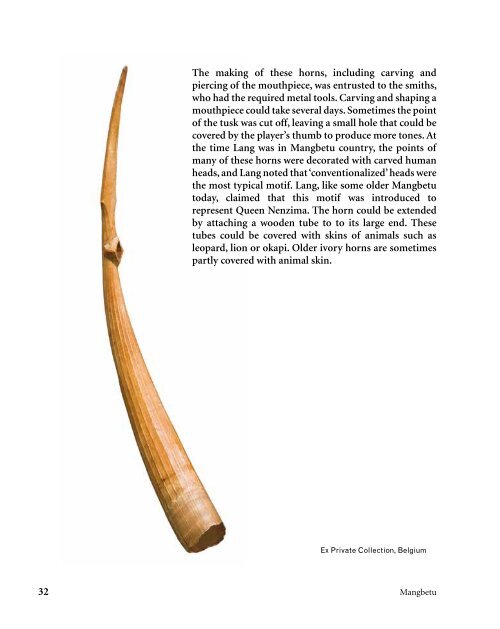Mangbetu Tribe (Bruno Claessens Gallerie 2011)
You also want an ePaper? Increase the reach of your titles
YUMPU automatically turns print PDFs into web optimized ePapers that Google loves.
The making of these horns, including carving and<br />
piercing of the mouthpiece, was entrusted to the smiths,<br />
who had the required metal tools. Carving and shaping a<br />
mouthpiece could take several days. Sometimes the point<br />
of the tusk was cut off, leaving a small hole that could be<br />
covered by the player’s thumb to produce more tones. At<br />
the time Lang was in <strong>Mangbetu</strong> country, the points of<br />
many of these horns were decorated with carved human<br />
heads, and Lang noted that ‘conventionalized’ heads were<br />
the most typical motif. Lang, like some older <strong>Mangbetu</strong><br />
today, claimed that this motif was introduced to<br />
represent Queen Nenzima. The horn could be extended<br />
by attaching a wooden tube to to its large end. These<br />
tubes could be covered with skins of animals such as<br />
leopard, lion or okapi. Older ivory horns are sometimes<br />
partly covered with animal skin.<br />
1. Private Collection. Sold at<br />
Christie’s, Paris, 11 June<br />
2007. (Lot 128, lenght: 97 cm)<br />
2. Ex Collection Marc & Denise<br />
Ginzberg, New York, USA.<br />
Published in Ginzberg<br />
(Marc), African Forms, Milano,<br />
2000:140 (lenght: 127 cm)<br />
1.<br />
2.<br />
Ex Private Collection, Belgium<br />
The materials used to make horns have changed in response to the changing economy<br />
and ecology of northeastern Congo. Instruments of wood, animal horn, and gourd<br />
have long been played throughout the region for hunting, signaling, and music. Far<br />
more labor and, consequently, patronage were required to catch an elephant and carve a<br />
horn out of a solid ivory tusk than to make an instrument of hollow antelope of buffalo<br />
horn. When international trade made ivory more valuable, it became associated with<br />
foreigners and chiefs’ relationships to them. Ivory horns, as a symbol of chieftaincy,<br />
became part of the <strong>Mangbetu</strong> court orchestra. Court dancers often held these ivory<br />
horns aloft as royal emblems; their symbolic value may have taken precedence over<br />
their musical function on these occasions. When tusks later became relatively scarce<br />
and hence more costly, chiefs had fewer ivory horns made, retaining older instruments<br />
for a longer time and replacing them with instruments of antelope horn.<br />
32 <strong>Mangbetu</strong> Material Culture<br />
33

















